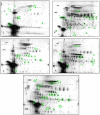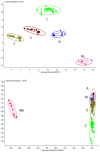Analysis of Urine Composition in Type II Diabetic Mice after Intervention Therapy Using Holothurian Polypeptides
- PMID: 28798909
- PMCID: PMC5526924
- DOI: 10.3389/fchem.2017.00054
Analysis of Urine Composition in Type II Diabetic Mice after Intervention Therapy Using Holothurian Polypeptides
Abstract
Hydrolysates and peptide fractions (PF) obtained from sea cucumber with commercial enzyme were studied on the hyperglycemic and renal protective effects on db/db rats using urine metabolomics. Compared with the control group the polypeptides from the two species could significantly reduce the urine glucose and urea. We also tried to address the compositions of highly expressed urinary proteins using a proteomics approach. They were serum albumins, AMBP proteins, negative trypsin, elastase, and urinary protein, GAPDH, a receptor of urokinase-type plasminogen activator (uPAR), and Ig kappa chain C region. We used the electronic nose to quickly detect changes in the volatile substances in mice urine after holothurian polypeptides (HPP) fed, and the results show it can identify the difference between treatment groups with the control group without overlapping. The protein express mechanism of HPP treating diabetes was discussed, and we suggested these two peptides with the hypoglycemic and renal protective activity might be utilized as nutraceuticals.
Keywords: express mechanism; function; holothurian polypeptides; type II diabetes; urine.
Figures




Similar articles
-
Expression of Urokinase-type Plasminogen Activator Receptor and its Soluble Form in Type 2 Diabetic Kidney Disease.Arch Med Res. 2019 Jul;50(5):249-256. doi: 10.1016/j.arcmed.2019.08.007. Epub 2019 Oct 5. Arch Med Res. 2019. PMID: 31593848
-
Renal synthesis of urokinase type-plasminogen activator, its receptor, and plasminogen activator inhibitor-1 in diabetic nephropathy in rats: modulation by angiotensin-converting-enzyme inhibitor.J Lab Clin Med. 2004 Aug;144(2):69-77. doi: 10.1016/j.lab.2004.04.002. J Lab Clin Med. 2004. PMID: 15322501
-
Effects of uPA on mesangial matrix changes in the kidney of diabetic rats.Ren Fail. 2014 Sep;36(8):1322-7. doi: 10.3109/0886022X.2014.934694. Epub 2014 Jul 10. Ren Fail. 2014. PMID: 25010090
-
Structure, function and expression on blood and bone marrow cells of the urokinase-type plasminogen activator receptor, uPAR.Stem Cells. 1997;15(6):398-408. doi: 10.1002/stem.150398. Stem Cells. 1997. PMID: 9402652 Review.
-
[Mechanism of tumor cell-induced extracellular matrix degradation--inhibition of cell-surface proteolytic activity might have a therapeutic effect on tumor cell invasion and metastasis].Nihon Sanka Fujinka Gakkai Zasshi. 1996 Aug;48(8):623-32. Nihon Sanka Fujinka Gakkai Zasshi. 1996. PMID: 8808830 Review. Japanese.
Cited by
-
Protein lysine four-carbon acylations in health and disease.J Cell Physiol. 2024 Mar;239(3):e30981. doi: 10.1002/jcp.30981. Epub 2023 Feb 23. J Cell Physiol. 2024. PMID: 36815448 Free PMC article. Review.
-
Sea Cucumber Peptides Ameliorate DSS-Induced Ulcerative Colitis: The Role of the Gut Microbiota, the Intestinal Barrier, and Macrophage Polarization.Nutrients. 2023 Nov 17;15(22):4813. doi: 10.3390/nu15224813. Nutrients. 2023. PMID: 38004208 Free PMC article.
-
2-hydroxyisobutyric acid (2-HIBA) modulates ageing and fat deposition in Caenorhabditis elegans.Front Mol Biosci. 2022 Nov 23;9:986022. doi: 10.3389/fmolb.2022.986022. eCollection 2022. Front Mol Biosci. 2022. PMID: 36533081 Free PMC article.
-
Research progress on the chemical components and biological activities of sea cucumber polypeptides.Front Pharmacol. 2023 Oct 16;14:1290175. doi: 10.3389/fphar.2023.1290175. eCollection 2023. Front Pharmacol. 2023. PMID: 37908979 Free PMC article. Review.
-
Monkfish (Lophius litulon) Peptides Ameliorate High-Fat-Diet-Induced Nephrotoxicity by Reducing Oxidative Stress and Inflammation via Regulation of Intestinal Flora.Molecules. 2022 Dec 28;28(1):245. doi: 10.3390/molecules28010245. Molecules. 2022. PMID: 36615439 Free PMC article.
References
LinkOut - more resources
Full Text Sources
Other Literature Sources
Research Materials
Miscellaneous

